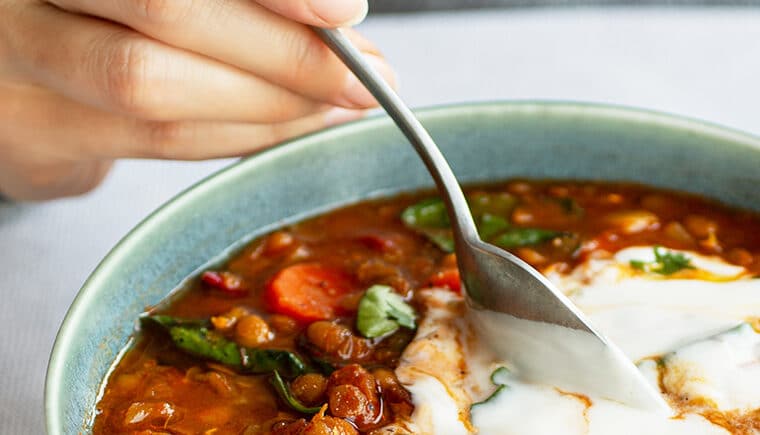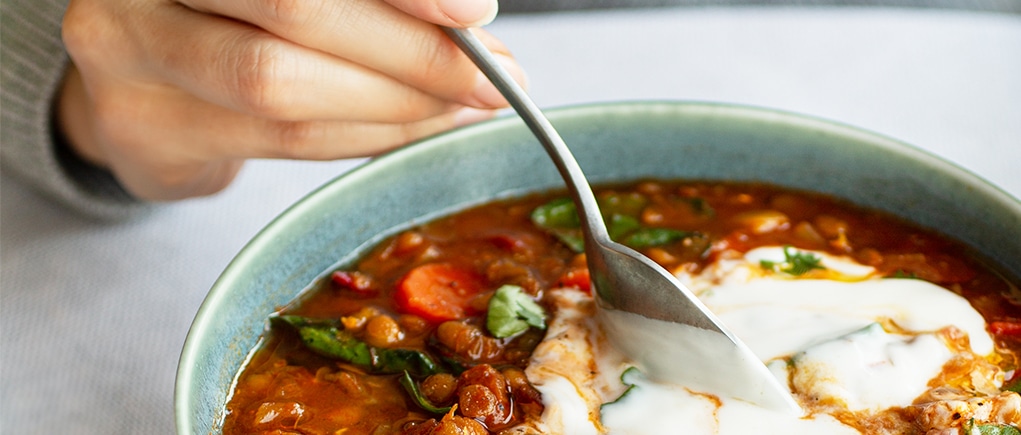



Learn about how much sodium you should eat per day, who’s more at risk and how to be mindful of how much sodium you are consuming.
February is American Heart Month. Some people who are newly adopting a vegan diet automatically assume that because it is a vegan diet, whatever you are eating is healthy and good for you. This is a misconception. Sometimes, when transitioning to a vegan diet, you can unintentionally consume more sodium, often in the form of packaged foods or meals at a restaurant. We still want to be aware of how much sodium is in our food because it can negatively impact our health. Let’s dive into why it’s still important to be mindful of sodium on a vegan diet and what practical changes we can make!
The American Heart Association recommends no more than 2,300mg of sodium per day for adults. That is equivalent to about one teaspoon of salt. Adults with high blood pressure should aim for </= 1,500mg of sodium per day. At least half of adults have high blood pressure.
The average amount of sodium that Americans consume on a daily basis is ~3,400mg according to the Dietary Guidelines for Americans 2020-2025. The range of sodium eaten daily can be as much as 5,000mg per day.
Becoming pregnant when you already have high blood pressure and it is not controlled can put you and your baby at risk. High blood pressure during pregnancycan harm the mother’s organs, lead to early delivery of your baby and low birth weight. Meeting with your health care team to form a plan is recommended.
A dietitian can help you work on food changes to lower your blood pressure before getting pregnant and continue to guide you throughout your pregnancy on the best food choices with low sodium vegan meals. With the right knowledge, blood pressure is controllable. Having a team of professionals on your side is one of the best things you can do to lower your risk!
High blood pressure is higher in African American men and women than in any other ethnic group. The reason for this, according to experts, is that there is a higher rate of obesity and diabetes. Other contributing factors include food access (widely available high-sodium foods/lack of access to fresh fruits and vegetables), economic constraints and lack of nutrition education. Traditions can mean a lot in the African American community, where family members will do what “mama did”. And if mama cooked using a lot of high-sodium foods and/or salt then that’s what the children know and grow up to do.
High blood pressure is very common with diabetes. About 6 out of 10 people with diabetes also have high blood pressure. Don’t be overwhelmed by this statistic because there is something you can do about it! Below, we’ll start to talk about what you can change and how to do it with a low sodium vegan approach.
Eating a high-sodium diet is a risk factor for high blood pressure, but there are other factors to be aware of, such as:
You can control what kind of food you put in your body, your activity level and if you choose to smoke or not. These are behaviors that can negatively affect our health, but we can make changes to them.
Start by looking at your daily food choices to improve your vegan diet. It is recommended to make small, actionable steps and not overload yourself with 10 goals at one time. In fact, it is better to start with 1-3 small actionable steps at a time. Once you feel like you’ve successfully implemented a goal, then add on a new goal. Take a look at a few examples below.
The above examples are all things we can do to improve our diet and reduce the risk of developing high blood pressure. It’s important to remember that reducing sodium in our diet is huge, but so are the other risk factors mentioned above.
Contrary to popular belief, the bulk of sodium we consume comes from packaged, processed and restaurant foods, not the salt shaker itself. About 70% of the sodium we consume comes from what we buy in grocery stores and restaurants.
Use nutrient claims on packages to start reducing the amount of sodium in your diet.
| What the claim says | What the claim means |
| Salt/sodium free | Less than 5 mg of sodium per serving |
| Very low sodium | 35 mg of sodium or less per serving |
| Low sodium | 140 mg of sodium or less per serving |
| Reduced sodium | At least 25% less sodium than the regular product |
| Light in sodium or lightly salted | At least 50% less sodium than the regular product |
| No salt added | No salt is added during processing |
Source:FDA.gov Sodium in Your Diet
This is especially useful when buying broths, stocks, and canned vegetables (including beans). If you are not able to buy unsalted or low-sodium canned vegetables, no worries! Simply drain them in a colander and rinse them under running water. This removes some of the sodium. You can also consider buying frozen vegetables without added sauces and seasonings.
Seasoned, packaged tofu is convenient, however, there can be a considerable difference between that and fresh, unseasoned tofu. When cooking, it helps to flavor yourself so that you can control how much sodium is added to your food.
Buy fewer foods high in sodium, like canned soups, frozen dinners, boxed macaroni and cheese and rice combinations. When you do want to buy any of these items, compare labels and pick the one with the least amount of sodium per serving.
As often as possible, prepare more homemade meals to reduce sodium. You may have heard this like a broken record, but meal planning can be a game changer. It doesn’t have to be a five-star meal every night. You can keep it simple with these great low-sodium plant-based recipes:
You can still enjoy eating out while being mindful of your food choices. Below are a few tips:

KeyVion Miller RDN, LD/N is a registered dietitian with a culinary nutrition certification and owner of The Miller’s Kitchen, a Southern food blog.